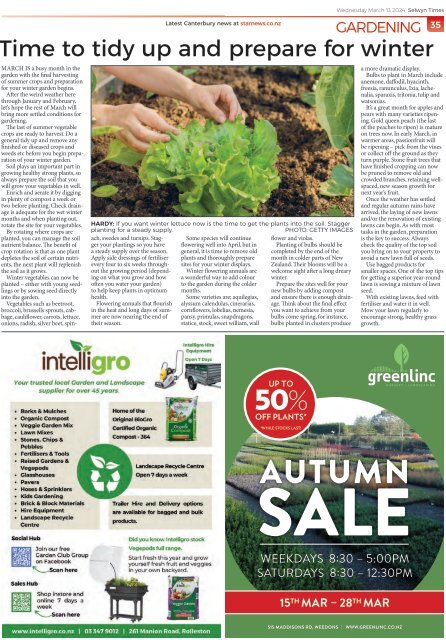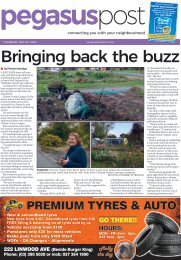Create successful ePaper yourself
Turn your PDF publications into a flip-book with our unique Google optimized e-Paper software.
ime to tidy up and prepare for winter<br />
MARCH IS a busy month in the<br />
garden with the final harvesting<br />
of summer crops and preparation<br />
for your winter garden begins.<br />
After the weird weather here<br />
through January and February,<br />
let’s hope the rest of <strong>March</strong> will<br />
bring more settled conditions for<br />
gardening.<br />
The last of summer vegetable<br />
crops are ready to harvest. Do a<br />
general tidy up and remove any<br />
finished or diseased crops and<br />
weeds etc before you begin preparation<br />
of your winter garden.<br />
Soil plays an important part in<br />
growing healthy strong plants, so<br />
always prepare the soil that you<br />
will grow your vegetables in well.<br />
Enrich and aerate it by digging<br />
in plenty of compost a week or<br />
two before planting. Check drainage<br />
is adequate for the wet winter<br />
months and when planting out,<br />
rotate the site for your vegetables.<br />
By rotating where crops are<br />
planted, you can manage the soil<br />
nutrient balance. The benefit of<br />
crop rotation is that as one plant<br />
depletes the soil of certain nutrients,<br />
the next plant will replenish<br />
the soil as it grows.<br />
Winter vegetables can now be<br />
planted – either with young seedlings<br />
or by sowing seed directly<br />
into the garden.<br />
Vegetables such as beetroot,<br />
broccoli, brussells sprouts, cabbage,<br />
cauliflower, carrots, lettuce,<br />
onions, radish, silver beet, spin-<br />
planting for a steady supply.<br />
ach, swedes and turnips. Stagger<br />
your plantings so you have<br />
a steady supply over the season.<br />
Apply side dressings of fertiliser<br />
every four to six weeks throughout<br />
the growing period (depending<br />
on what you grow and how<br />
often you water your garden)<br />
to help keep plants in optimum<br />
health.<br />
Flowering annuals that flourish<br />
in the heat and long days of summer<br />
are now nearing the end of<br />
their season.<br />
Latest Canterbury news at starnews.co.nz<br />
HARDY: If you want winter lettuce now is the time to get the plants into the soil. Stagger<br />
Some species will continue<br />
flowering well into April, but in<br />
general, it is time to remove old<br />
plants and thoroughly prepare<br />
sites for your winter displays.<br />
Winter flowering annuals are<br />
a wonderful way to add colour<br />
to the garden during the colder<br />
months.<br />
Some varieties are; aquilegias,<br />
alyssum calendulas, cinerarias,<br />
cornflowers, lobelias, nemesia,<br />
pansy, primulas, snapdragons,<br />
statice, stock, sweet william, wall<br />
PHOTO: GETTY IMAGES<br />
flower and violas.<br />
Planting of bulbs should be<br />
completed by the end of the<br />
month in colder parts of New<br />
Zealand. Their blooms will be a<br />
welcome sight after a long dreary<br />
winter.<br />
Prepare the sites well for your<br />
new bulbs by adding compost<br />
and ensure there is enough drainage.<br />
Think about the final effect<br />
you want to achieve from your<br />
bulbs come spring, for instance,<br />
bulbs planted in clusters produce<br />
Wednesday <strong>March</strong> <strong>13</strong> <strong>2024</strong> <strong>Selwyn</strong> <strong>Times</strong><br />
GARDENING 35<br />
a more dramatic display.<br />
Bulbs to plant in <strong>March</strong> include<br />
anemone, daffodil, hyacinth,<br />
freesia, ranunculus, Ixia, lachenalia,<br />
sparaxis, tritonia, tulip and<br />
watsonias.<br />
It’s a great month for apples and<br />
pears with many varieties ripening.<br />
Gold queen peach (the last<br />
of the peaches to ripen) is mature<br />
on trees now. In early <strong>March</strong>, in<br />
warmer areas, passionfruit will<br />
be ripening – pick from the vines<br />
or collect off the ground as they<br />
turn purple. Stone fruit trees that<br />
have finished cropping can now<br />
be pruned to remove old and<br />
crowded branches, retaining wellspaced,<br />
new season growth for<br />
next year’s fruit.<br />
Once the weather has settled<br />
and regular autumn rains have<br />
arrived, the laying of new lawns<br />
and/or the renovation of existing<br />
lawns can begin. As with most<br />
tasks in the garden, preparation<br />
is the key to success. Always<br />
check the quality of the top soil<br />
you bring on to your property to<br />
avoid a new lawn full of seeds.<br />
Use bagged products for<br />
smaller spaces. One of the top tips<br />
for getting a superior year-round<br />
lawn is sowing a mixture of lawn<br />
seed.<br />
With existing lawns, feed with<br />
fertiliser and water it in well.<br />
Mow your lawn regularly to<br />
encourage strong, healthy grass<br />
growth.<br />
UP TO<br />
50%<br />
OFF PLANTS*<br />
*WHILE STOCKS LAST!<br />
AUTUMN<br />
WEEKDAYS 8:30 – 5:00PM<br />
SATURDAYS 8:30 – 12:30PM<br />
15 TH MAR – 28 TH MAR<br />
515 MADDISONS RD, WEEDONS | WWW.GREENLINC.CO.NZ


















